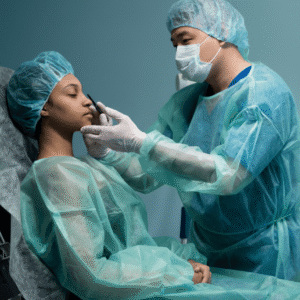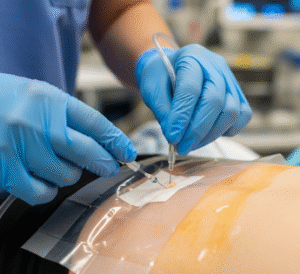Overview
Breast cancer is a malignant tumor that forms in the breast tissue, usually in the ducts or lobules. It is one of the most common cancers affecting women worldwide, including Korea, and can also occur in men, though rarely. Early detection and treatment are critical for improving survival and preserving quality of life.
In Korea, breast cancer management involves advanced diagnostic imaging, minimally invasive surgery, chemotherapy, targeted therapy, radiation therapy, and comprehensive rehabilitation programs. Leading hospitals and cancer centers in Korea provide personalized care plans combining surgical, medical, and supportive treatments to optimize outcomes.
What is Breast Cancer?
Breast cancer occurs when breast cells grow uncontrollably, forming malignant tumors that can invade surrounding tissue or metastasize to other parts of the body.
Types of breast cancer include:
- Ductal carcinoma in situ (DCIS): Non-invasive cancer in the milk ducts
- Invasive ductal carcinoma (IDC): Most common type, spreads beyond ducts
- Invasive lobular carcinoma (ILC): Begins in the lobules
- Triple-negative breast cancer: Lacks estrogen, progesterone, and HER2 receptors, often more aggressive
- HER2-positive breast cancer: Overexpresses the HER2 protein, responsive to targeted therapy
- Inflammatory breast cancer: Rare and aggressive, causing redness and swelling
Breast cancer can also be classified based on stage and grade, reflecting tumor size, lymph node involvement, and metastasis.
Symptoms
Early-stage breast cancer may have no symptoms, which is why regular screening is important. Possible symptoms include:
- Lump or thickening in the breast or underarm
- Changes in breast size, shape, or appearance
- Nipple discharge (sometimes bloody)
- Nipple inversion or retraction
- Skin changes: Dimpling, redness, or swelling
- Pain or tenderness, though often painless
- Enlarged lymph nodes in the armpit
Causes
The exact cause of breast cancer is complex and multifactorial, involving:
- Genetic mutations: BRCA1, BRCA2, and other hereditary gene mutations
- Hormonal factors: Long-term estrogen exposure
- Environmental exposures: Radiation or carcinogens
- Lifestyle factors: Alcohol consumption, obesity, lack of physical activity
- Age: Risk increases with age
- Family history: Especially first-degree relatives with breast or ovarian cancer
Risk Factors
- Gender: Women are at higher risk
- Age: Most common after 50, but can occur earlier
- Family history and genetics: BRCA mutations increase risk significantly
- Reproductive history: Early menstruation, late menopause, or late first childbirth
- Hormone replacement therapy
- Obesity and sedentary lifestyle
- Alcohol consumption and smoking
- Previous breast disease or cancer
Complications
If untreated or advanced, breast cancer can lead to:
- Metastasis: Spread to lymph nodes, bones, liver, lungs, or brain
- Lymphedema: Swelling of the arm after lymph node removal
- Recurrence in the breast or elsewhere
- Pain and reduced mobility
- Psychological distress, including anxiety and depression
- Complications from treatments, such as infection, nausea, or cardiotoxicity
Prevention
While not all breast cancer is preventable, risk reduction strategies include:
- Regular screenings: Mammograms, ultrasounds, and MRI for high-risk individuals
- Healthy lifestyle: Regular exercise, balanced diet, limited alcohol, and no smoking
- Weight management
- Genetic counseling and testing for those with family history
- Awareness of breast changes and prompt medical evaluation
Treatment Options in Korea
Diagnosis
Accurate diagnosis is crucial for treatment planning:
- Mammography: Standard screening tool
- Breast ultrasound: Evaluates lumps and dense breast tissue
- MRI: Detailed imaging for high-risk patients
- Biopsy: Confirms cancer type and grade
- Hormone receptor and HER2 testing: Guides targeted therapy
- Genetic testing for hereditary risk assessment
Medical Management
- Chemotherapy: Systemic treatment to destroy cancer cells
- Hormone therapy: For estrogen or progesterone receptor-positive cancers
- Targeted therapy: Drugs like trastuzumab for HER2-positive cancers
- Immunotherapy: Emerging treatment for specific subtypes
Surgical Management
- Lumpectomy: Removal of the tumor with breast conservation
- Mastectomy: Removal of one or both breasts
- Sentinel lymph node biopsy: Identifies lymph node involvement
- Axillary lymph node dissection if cancer has spread
Radiation Therapy
- External beam radiation: Often after lumpectomy
- Brachytherapy: Internal radiation for localized treatment
Supportive Care
- Rehabilitation: Physical therapy for mobility and strength
- Psychological support: Counseling and support groups
- Nutritional guidance and pain management
- Long-term monitoring for recurrence and secondary cancers
Prognosis
Prognosis depends on cancer stage, type, grade, and treatment response:
- Early-stage breast cancer has high survival rates with timely treatment
- Advanced or metastatic cancer requires ongoing management but can be controlled with modern therapies
- Korean hospitals offer multidisciplinary teams, cutting-edge surgical techniques, targeted therapies, and comprehensive follow-up, improving survival and quality of life
- Personalized treatment plans based on genetic, molecular, and clinical factors optimize outcomes
With world-class cancer care, advanced diagnostics, and holistic patient support, Korea provides excellent outcomes for breast cancer patients, focusing on survival, functional recovery, and quality of life.













